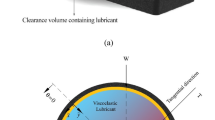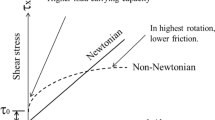Abstract
In this article, we propose a framework for a detailed finite element analysis of elastohydrodynamic lubrication in ball bearings. Our contribution to this field is twofold. First, we present a fully monolithic ALE method for the treatment of fluid–structure interaction. For the lubricant, we use the full Navier–Stokes equations in combination with a pressure-dependent viscosity law and include thermal effects. Second, we introduce a novel method for a fully implicit treatment of the evolution of the lubricants’ free surface using Nitsches method. This allows for arbitrarily large time steps independent of the spatial discretization. Despite the variety of numerical challenges present in this application, such as anisotropy and extreme values of pressure, our approach for the first time shows robustness up to high rotational speeds as required in industrial applications. We describe the numerical ingredients we use in detail and present numerical results that validate our approaches and demonstrate its capabilities.














Similar content being viewed by others
References
Almqvist T, Larsson R (2002) The Navier–Stokes approach for thermal EHL line contact solutions. Tribol Int 35:163–170
Annavarapu C, Hautefeuille M, Dolbow JE (2012) A robust Nitsche’s formulation for interface problems. Comput Methods Appl Mech Eng 225–228:44–54
Apel T, Knopp T, Lube G (2008) Stabilized finite element methods with anisotropic mesh refinement for the Oseen problem. Appl Numer Math 58(12):1830–1843
Bänsch E (2001) Finite element discretization of the Navier–Stokes equations with a free capillary surface. Numer Math 88(2): 203–235
Bayada G, Chambat M (1986) The transition between the Stokes equations and the Reynolds equation: a mathematical proof. Appl Math Optim 14(1):73–93
Becker R, Braack M (2001) A finite element pressure gradient stabilization for the Stokes equations based on local projections. Calcolo 38(4):173–199
Becker R, Braack M, Meidner D, Richter T, Vexler B (2005) The finite element toolkit Gascoigne. http://www.gascoigne.de. Accessed July 2013
Belytschko T (1980) Fluid–structure interaction. Comput Struct 12:459–469
Braack M (2008) A stabilized finite element scheme for the Navier–Stokes equations on quadrilateral anisotropic meshes. M2AN. Math Model Numer Anal 42(6):903–924
Braack M, Richter T (2006) Solutions of 3D Navier–Stokes benchmark problems with adaptive finite elements. Comput Fluids 35(4):372–392
Brackbill JU, Kothe DB, Zemach C (1992) A continuum method for modeling surface tension. J Comput Phys 100(2):335–354
Bruyere V, Fillot N, Morales-Espejel G, Vergne P (2012) Computational fluid dynamics and full elasticity model for sliding line thermal elastohydrodynamic contacts. Tribol Int 46(1):3–13
Dettmer W, Perić D (2006) A computational framework for free surface fluid flows accounting for surface tension. Comput Methods Appl Mech Eng 195(23–24):3038–3071
Dunne T, Rannacher R, Richter T (2010) Numerical simulation of fluid-structure interaction based on monolithic variational formulations. In: Galdi GP, Rannacher R (eds) Fundamental trends in fluid–structure interaction, Contemp. Chall. Math. Fluid Dyn. Appl., vol. 1. World Sci. Publ., Hackensack, pp 1–75
Franta M, Málek J, Rajagopal KR (2005) On steady flows of fluids with pressure- and shear-dependent viscosities. Proc R Soc Lond Ser A Math Phys Eng Sci 461(2055):651–670
Girault V, Raviart PA (1979) Finite element methods for the Navier–Stokes equations. Springer, Berlin
Gohar R (2001) Elastohydrodynamics, 2nd edn. World Scientific Publishing, Singapore
Hamrock B, Dowson D (1976) Isothermal elastohydrodynamic lubrication of point contacts. Tech. rep, NASA
Hamrock B, Schmid S, Jacobson B (2004) Fundamentals of fluid film lubrication, 2nd edn. Marcel Decker, Inc., New York
Hansbo A, Hansbo P (2002) An unfitted finite element method, based on Nitsche’s method, for elliptic interface problems. Comput Methods Appl Mech Eng 191(47–48):5537–5552
Hart D, Berzins M, Goodyer C, Jimack P (2011) Using adjoint error estimation techniques for elastohydrodynamic lubrication line contact problems. Int J Numer Methods Fluids 67:1559–1570
Hertz H (1882) Über die Berührung fester elastischer Körper. Journal für die reine und angewandte Mathematik 92:156–171
Hirt C, Amsden A, Cook J (1974) An Arbitrary Lagrangian–Eulerian computing method for all flow speeds. J Comput Phys 14:227–469
Hron J, Turek S (2006) A monolithic FEM/multigrid solver for an ALE formulation of fluid-structure interaction with applications in Biomechanics. In: Bungartz JJ, Schäfer M (eds) Fluid–structure interaction. Springer, Berlin, pp 146–170
Hughes TJR, Brooks AN (1982) Streamline upwind/Petrov-Galerkin formulation for convection dominated flows with particular emphasis on the incompressible navier-stokes equation. Comput Methods Appl Mech Eng 32:199–259
Hughes TJR, Franca LP, Balestra M (1986) A new finite element formulation for computational fluid dynamics. V. Circumventing the Babuška-Brezzi condition: a stable Petrov-Galerkin formulation of the Stokes problem accommodating equal-order interpolations. Comput Methods Appl Mech Eng 59:85–99
Jubault I, Molimard J, Lubrecht A, Mansot J, Vergne P (2003) In situ pressure and film thickness measurements in rolling/sliding lubricated point contacts. Tribol Lett 15(4):421–429
Knauf S (2011) Numerical simulations for ball bearings considering fluid–structure-interaction problems and non-newtonian fluids with a free boundary. Ph.D. thesis, Ruprecht-Karls-Universität Heidelberg.
Kr̃upka I, Hartl M, Lis̃ka M (2005) The influence of contact pressure on central and minimal film thickness within ultrathin film lubricated contacts. J Tribol 127:890–892
Nilsson B, Hansbo P (2011) A Stokes model with cavitation for the numerical simulation of hydrodynamic lubrication. Int J Numer Methods Fluids 67(12):2015–2025
Nitsche J (1971) Über ein Variationsprinzip zur Lösung von Dirichlet-Problemen bei Verwendung von Teilräumen, die keinen Randbedingungen unterworfen sind. Abh. Math. Sem. Univ. 36:9–15
Ohno N, Kuwano N, Hirano F (1995) Bulk modulus of solidified oil at high pressure as predominant factor affecting life of trust ball bearings. Tribol Trans 38:285–292
Rajagopal KR, Szeri AZ (2003) On an inconsistency in the derivation of the equations of elastohydrodynamic lubrication. R Soc Lond Proc Ser A Math Phys Eng Sci 459(2039):2771–2786
Souli M, Zolesio J (2001) Arbitrary Lagrangian–Eulerian and free surface methods in fluid mechanics. Comput Methods Appl Mech Eng 191(3–5):451–466
Tezduyar T, Mittal S, Ray S, Shih R (1992) Incompressible flow computations with stabilized bilinear and linear equal-order-interpolation velocity–pressure elements. Comp Methods Appl Mech Eng 95:221–242
Acknowledgments
This work was supported by the German Federal Ministry of Education and Research (BMBF) under contract no. 50 YB 0807 (VING II project), which is gratefully acknowledged. Furthermore, we would like to thank our industrial partner Rockwell Collins Germany GmbH for discussions on the physics of ball bearings and for providing the data used in our simulations.
Author information
Authors and Affiliations
Corresponding author
Rights and permissions
About this article
Cite this article
Knauf, S., Frei, S., Richter, T. et al. Towards a complete numerical description of lubricant film dynamics in ball bearings. Comput Mech 53, 239–255 (2014). https://doi.org/10.1007/s00466-013-0904-1
Received:
Accepted:
Published:
Issue Date:
DOI: https://doi.org/10.1007/s00466-013-0904-1




